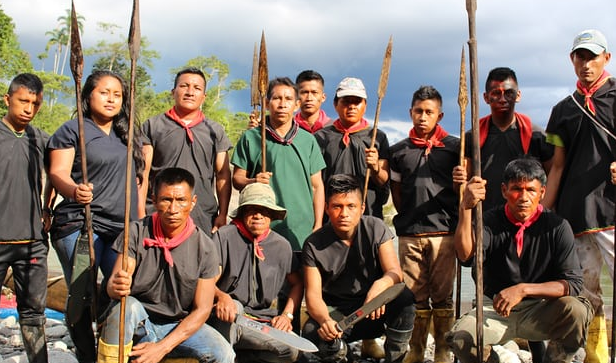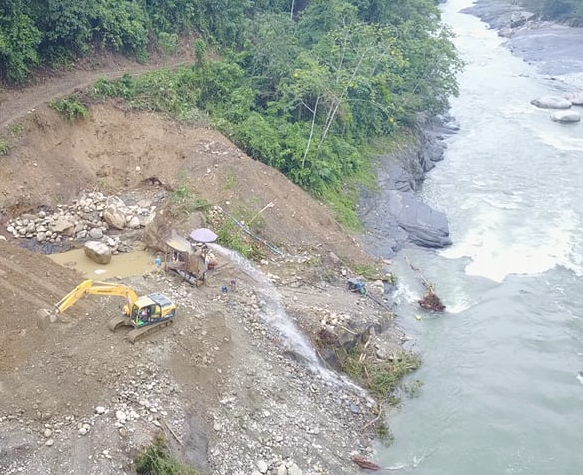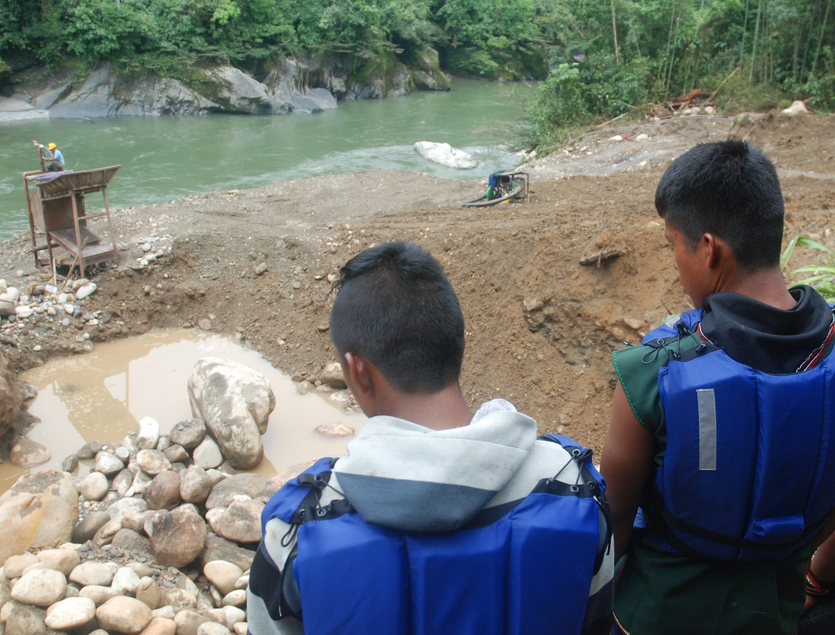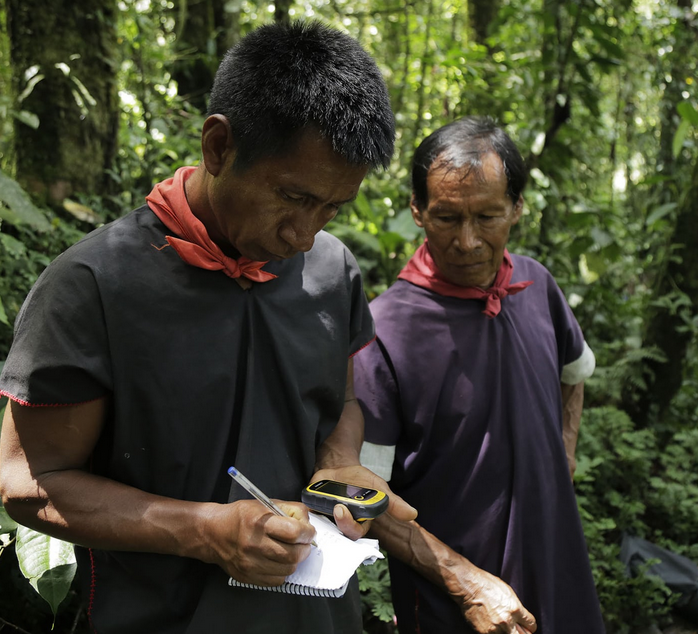Indigenous Cofans pledge to fight against illegal mining that pollutes their rivers

Cofan warriors pledge to protect their native lands.
By David Hill
Three A’I Cofan men were staring down at a pit of rocks, dead foliage and filthy water where two gold-panners were working. Beyond was a sluice and hoses running down to the rushing, green waters of the River Aguarico. To the right, there was mud, more rocks, more equipment, a makeshift tent and camp. Behind, to the left, a Hyundai excavator and a track running downriver.
No more than two weeks before, no track had existed and all this had been primary forest. Now that was gone. Only an area about 110 x 50 metres, you might say, but this is how gold rushes start.

New mining site on the Sinangoe River
Down below, several other A’I Cofan men – most wearing tunics, kerchiefs and life-jackets after a rocky canoe ride — were standing with one of the miners. He said his name was “Joselito” and he wore a yellow hardhat and pique shirt suggesting he was from the nearest village, Puerto Libre. Minutes before, the miners had been pumping water through the sluice and the excavator had been filling in the pit, but all that stopped with the arrival of the A’I Cofan – most immediately concerned if the miners were using mercury and the potentially catastrophic impacts on their village, Sinangoe, less than an hour downriver.
Joselito told the Guardian and others standing there that wasn’t the case. No mercury. “Eight years in prison [if you do that],” he said at least twice.
The new mining site is in a concession awarded to one Celso Amable Ureno Quezada in January 2018, according to the Ministry of Mines, in Sucumbíos province in a stunning part of the Ecuadorian Amazon. Joselito claimed it was his first day working there and he didn’t know who the concession belonged to, although he identified one of the others, a woman he called Alejandra Cortes, as the “boss.” Asked if the concession had obtained its licence from the Ministry of Environment, as is required by Ecuadorian law, Joselito almost laughed and said he didn’t know anything about that.
The miners had been spotted and filmed by drone the previous day, but Sinangoe’s president, Mario Criollo, had been warned they might soon be there when earlier in the week he had visited operations on a large beach slightly downriver, purportedly within the same concession. Accompanied by representatives from the Defensoría del Pueblo and government water agency SENAGUA, Criollo saw the same excavator and noticed a track recently cleared through the forest along the riverbank. According to Criollo, he had been told the plan is for the track — or rather, a road — to run all the way up to the northernmost tip of the concession towards the confluence of the River Cofanes and River Chingual, where form the River Aguarico.
Prior to that, in late February, Criollo had visited the same beach with a representative of the Sucumbíos province’s public prosecutors’ office, environmental police, other A’I Cofan and two NGOs supporting Sinangoe: the indigenous-run Alianza Ceibo, based in Sucumbíos, and the international Amazon Frontlines. The prosecutors’ office had been informed that allegedly the miners were operating illegally, without a licence, just outside the concession, and impacting the Cayambe Coca National Park. No arrests were made.

Corfan men observe another mining site, downstream.
Criollo is shocked at how quickly the miners are moving. “We did a reccy two months ago and there was nothing like this there then,” he told the Guardian. “In two months they’ve made major advances. Maybe in four years they’d clear the entire riverbank. We don’t want it to get to that. That’s why we’re monitoring what’s happening.”
Criollo seems most concerned about the potential impacts on the River Aguarico. A major tributary of the River Napo, which in turn is a major tributary of the River Amazon, it is a crucial source of water for the A’I Cofan in Sinangoe — not to mention thousands of other people even further downriver. Another concern is the colonization that a concession and road might encourage, making it easier for miners and others to cross to the other side of the river to the national park and Sinangoe’s own land.
Criollo emphasizes that his community doesn’t want to take control of the concession area, although he acknowledges that it is considered to be ancestral Cofan territory. Sinangoe already has an agreement dating from 1998 to use 13,700 hectares within the park — but no legal title — and in total it claims land rights over more than 55,000 hectares stretching westwards.
“Our interest in [the concession upriver from Sinangoe] isn’t about obtaining more land,” Criollo says. “It’s not that we want to cut that forest down ourselves, or mine for gold, or exploit oil. It’s just that we don’t want the water to be contaminated.”
Concern about the water is echoed by Nixon Narvaez, a 20 year old A’I Cofan man receiving communications training from the Alianza Ceibo who photographed the recent visit to the new site. He calls what they found “a little horrific”, saying the riverbank is “literally” being destroyed and the river risks being contaminated.
“We live along the banks of the river,” Narvaez told the Guardian. “It is fundamental to our lives. We drink the water, we bathe in it, we fish. Maybe the fish are being contaminated and our health will be endangered. It’d be better if the concession was cancelled.”

Cofan guards take environmental readings in the forest.
Similar concerns are expressed by Alex Lucitante, an A’I Cofan man with the Alianza Ceibo. “The River Aguarico is a source of life,” he told the Guardian. “As indigenous peoples, we rely on it for our families’ subsistence. It has already been difficult enough following the contamination caused by oil companies [downriver], which was never cleaned up. But now, with this mining, it would be a kind of double hit — a very serious risk.”
Back in Sinangoe, on the day the A’I Cofan returned from the new mining site, a Ministry of Environment park guard and two scientists paid a surprise visit to discuss a proposed “conservation corridor” in the region. According to a map given to Criollo, this would stretch across a huge swathe of northern Ecuador from the Cotacachi Cayapas Ecological Reserve to the Cofan Bermejo Ecological Reserve on the border with Colombia, and would include the north of Sinangoe and the national park.
Neither scientist said he was previously aware of the mining concession or operations upriver. Milton Tirado, a botanist, told the Guardian he had been contracted by Spanish company INYPSA to develop the corridor proposal for the Ministry of Environment, but is financed by the German government bank KfW. He says he is “totally” concerned because “the mining would affect our project’s objectives to establish conservation corridors.”
The concession upriver from Sinangoe, named Puerto Libre, is actually just one of four concessions bordering the community and national park that have been awarded in recent months — two in January, one in December 2017, one in August 2017. In addition, there are another six concessions along the River Chingual. While the A’I Cofan are already extremely concerned about Puerto Libre, the potential cumulative impacts of all 10 concessions are unimaginable.
According to Alex Lucitante, the A’I Cofan federation Nacionalidad Originaria A’I Kofan del Ecuador (NOA’IKE) is “extremely concerned” about the concessions. He told the Guardian that some of them run for up to 25 years and they will impact not only Sinangoe but other parts of A’I Cofan ancestral territory, as well as other indigenous peoples downriver. “I’m not just speaking as an A’I Cofan leader, but thinking of the other indigenous nationalities living along the Aguarico,” he says.
These newest concessions bordering Sinangoe have appeared despite recent pledges by Ecuador’s president Lenín Moreno that no new mining concessions would be awarded. In December 2017 he was reported to have told indigenous federation CONAIE and other indigenous leaders after 1,000s of people marched to the capital Quito that there would be “no more mining concessions in Ecuador”, and then in February he was reported to make similar comments during a visit to the Morona Santiago province. According to Agence France-Presse (AFP), he said that mining had “severely” contaminated the country’s rivers, that he had previously promised “not one concession more”, that the government had backtracked on awarding 2,000 new concessions, that some new concessions had been awarded anyway, and that he had asked the Minister of Mines to resign.
“I had to, unfortunately, tell the Minister that my promise must be met and [therefore] he had to go home,” AFP quoted Moreno saying.
The new concessions upriver from Sinangoe — large-scale, supposedly legal, but possibly involving mercury — have come after years of small-scale, illegal miners and others invading the community, and within less than a year of the A’I Cofan initiating a series of concerted efforts to repel them. The first of these efforts has been to conduct systematic monitoring with mapping and GPS, drones, camera traps — three of which have since been stolen — and conventional film and photography.
The results of the monitoring have been startling, although not particularly surprising: dozens of miners using sluices, dredges and other equipment entering Sinangoe, along with hunters, loggers and fishermen. Some fishermen have used dynamite, while others have half-dammed one river to stun fish with a toxic plant known as barbasco. At least six shot-gun traps have been found – intended for peccary and other wild game but equally fatal if one of the A’I Cofan walked into them — and on at least four occasions metal cables have been found strung across the river.
Who are the miners? Criollo and others say some are “colonos” from Puerto Libre, some from elsewhere in Ecuador, others Colombians. Some people from the community itself mine too, but it is limited and only involves panning.
In addition to the monitoring, Sinangoe has formed a “guardia indigena” of almost 20 people and promulgated its own law, as is arguably its right under Ecuador’s Constitution, international law and the United Nations Declaration on the Rights of Indigenous Peoples. This happened after just three months monitoring, once the A’I Cofan realized how many people were invading. The law, dated May 2017, prohibits outsiders from conducting “any kind of mining activity with pan, sluice, winch, dredge and/or other equipment”, from “any kind of fishing using unconventional methods such as barbasco, poison, dynamite, water pistols, nets and/or other equipment”, and from “any kind of hunting using traps, shotguns, dogs and/or other unconventional methods.”
Local authorities soon became aware of the law, reportedly leading to a “drastic increase” in threats made to Criollo and other community members. When the number of invaders continued to remain high, the A’I Cofan held a public event on 14 September in order to further spread awareness of the law. The event was broadcast live on Radio Sucumbíos and attended by the provincial governor and representatives of the public prosecutors’ office, Defensoría del Pueblo, Ministry of Mines, Ministry of Environment, Ministry of Interior, other A’I Cofan communities and other indigenous leaders.
“Our message is very clear,” Criollo said in a press release at the time. “We want our neighbours to respect us and our territory. For many years we have witnessed invaders exploiting the resources in our ancestral territory without our consent. Today we are saying, ‘No more.’”
That press release quoted one of the few female members of Sinangoe’s guardia, Lisbeth Narvaez. “Our territory is our life,” she said. “This new process of territorial defense is historic, legitimate and crucial to ensure the protection of our rights and to maintain the integrity of our ancestral lands. We call on all communities of A’I Cofan nationality and other nationalities in the Ecuadorian Amazon to support this process and fight for the defense of their territories.”
To date, the law appears to have had some impact. Although a report by Sinangoe in September stated that the number of miners remained high and some of the same people were repeatedly entering, the situation is reported to have improved since the public event. Nixon Narvaez puts that down to the establishment of the guardia too, whose members are responsible for enforcing the law.
“Before the law there was a lot of people entering,” he says. “Since then, things have quieted down a little.”
The irony that the A’I Cofan themselves have had to make such efforts – even though their land is in a supposedly protected national park established in 1979, almost 40 years ago – is not lost on the community. According to the park’s Management Plan, it is the most important water reserve in northern Ecuador, supplying Quito with “almost all” its water, and it is home to the country’s third biggest volcano, “extraordinary” biodiversity, the stunning 160m-high San Rafael waterfall and a “great number of species that are endemic or new to science that aren’t protected in any other part of the world.” The website of the Ministry of Environment, which runs the park, dubs it “the national park of water.”
But among the A’I Cofan in Sinangoe frustration with the Ministry clearly runs deep. Community members argue that the park was established without consulting them, and the Ministry takes no serious measures to protect the part where they live. This is despite the fact that the Management Plan, dating from almost 10 years ago, acknowledges the park’s “great mining potential” and the potential pressure on the area as a result.
Last November the Ministry of Environment, together with various other state institutions, did pay a rare visit to Sinangoe. A Ministry report acknowledges that evidence of mining was found and several commitments to the community were made, but the trip itself was cut short and various institutions were slow to report back to the A’I Cofan – further fuelling their frustration.
“We’ve called the Ministry many times, but they don’t do anything,” Criollo told the Guardian. He wasn’t just talking about mining. “For example, when we’ve seen a fisherman using dynamite.”
Nixon Narvaez puts it another way: the Ministry and park are regulated by a “ley de afuera” – laws promulgated in Quito. “They don’t have any value here,” he says. “The Ministry comes but doesn’t do anything. They don’t enter. They’ve never said to us, “Let’s go, guys [into the park]!”
The sudden appearance of the miners in the concession upriver from Sinangoe has come at a particularly crucial moment for mining in Ecuador. In February it was the subject of one of seven questions in a national referendum, with 68% of Ecuadorians voting against mining in protected and certain other areas. In March over 1,000 people marched to Quito to mark World Water Day and raise awareness of the dangers posed by the industry, and female indigenous leaders met president Moreno to request an end to all operations in their territories. A collective of organisations and individuals, “Caminantes”, has emerged calling for all concessions to be annulled. On 16 April a march is planned in the north of the country, with members of Sinangoe due to participate.
Luisana Aguilar, from the Comision Ecumenica de Derechos Humanos (CEDHU), told the Guardian that the Caminantes have adopted their position after “10 years of no dialogue and the violent imposition” of concessions and mines.
“Some initial achievements have already been made: putting the issue on the political agenda, getting a question about mining into the referendum, the offer to award no new concessions, the Minister’s dismissal and the backtracking on some concessions [in the process of being established],” Aguilar says. “We believe that this is the moment when Ecuador must make a decision: either take a step back, annul the concessions and build a post-extractivist economy, or continue along the same lines and pursue profit at the expense of mega-biodiversity, indigenous territories and campesino communities.”
Yet at the same time approximately 15% of the country is included in mining concessions and despite the recent decision to backtrack on some new ones, a further 170,000 hectares were awarded between December 2017 and February, mostly to Australian, Canadian, Chilean and Chinese companies, according to the Coordinadora Ecuatoriana de Organizaciones para la Defensa del Ambiente y la Naturaleza (CEDENMA). Last week Quito hosted an international mining conference, “Ecuador minero por buen camino”, where the acting Minister of Mines said that $4.5 billion is expected to be invested over the next few years in mining projects already under construction, and exports and other revenue streams will generate a further $5 billion.
“Our national policy is defined and looks to attract and encourage private, national and foreign investment which will be productive and socially and environmentally responsible, and generate decent employment,” the Minister, Rebeca Illescas, was reported to say. “About 5,000 jobs have already been directly created and it is calculated that the strategic projects [San Carlos Panantza, Rio Blanco, Loma Larga, Mirador and Fruta del Norte, all towards the south of the country] will generate roughly 25,000 jobs directly and indirectly through to 2021.”
Meanwhile, in the La Merced de Buenos Aires parish in Imbabura province, slightly to the north-west of Sinangoe, a much-publicized gold rush has been taking place. The Ministry of Mines issued a statement last week estimating there are more than 3,000 people mining illegally in that region, saying it is committed to “combatting and eradicating illegal mining” and that it has detained over 130 people.
Joselito, upriver from Sinangoe, had mentioned the Buenos Aires gold rush when recently confronted by the A’I Cofan. He estimated there are 5,000 people there and appeared to claim mercury was being used, unlike at his site along the River Aguarico.
But was he telling the truth? Earlier this year Amazon Frontlines’s Nicolas Mainville, a French-Canadian biologist specializing in mercury contamination in the Amazon, recorded the president of Puerto Libre’s small-scale miners’ association saying that some operators — distinct from his association — have been using mercury on the River Aguarico. Mainville believes that many other people in the region would agree with that, and he has taken soil and water samples from the large beach just downriver from the new site where the same excavator and sluice had previously been operating.
“I really don’t know and I sincerely hope they aren’t, but everybody we’ve talked to says yes,” says Mainville, who piloted the drone over the new site. “Because economically it just makes little sense to have all that machinery — the excavator and the sluice — and all those people and not use mercury. Because if you don’t use mercury, you just use sight. You have to sift through everything. It’s incredibly inefficient at that scale. With that sluice, and with mercury, all the gold would be sticking. Everyone I’ve spoken to says, “Of course they’ve been using mercury.””
The A’I Cofan in Sinangoe aren’t sure either. But both Narvaez and Criollo appear aware of the potentially devastating consequences and are waiting for the samples results. The community has requested that the Ministry of Environment take samples too, but nothing has yet been done.
“We don’t know, but if they’re using mercury it could be extremely dangerous,” says Alex Lucitante, from the Alianza Ceibo. “We understand what it is, what it can cause, what harm it can do. It’s very toxic. That’s what concerns us the most. That’s mainly why we’re rising up and fighting.”
The Ministry of Environment, Ministry of Mines, National Communications Secretariat and INYPSA did not respond to questions from the Guardian. Celso Amable Ureno Quezada could not be reached.
_____________________
Credit: The Guardian, www.theguardian.com




















